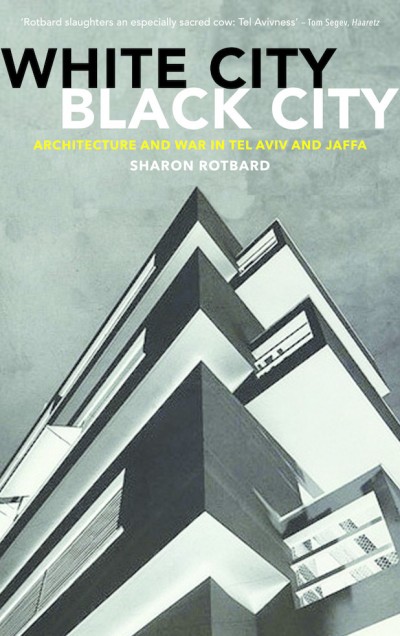The “Forced Geography” of Tel Aviv – White City, Black City: Architecture and War in Tel Aviv and Jaffa

White City, Black City: Architecture and War in Tel Aviv and Jaffa by Sharon Rotbard (Pluto Press, 256pp)
On 11 January 2013, around 250 activists erected tents on privately owned Palestinian land in the occupied West Bank, on which the Israeli government intended to build a 4,000-house settlement. The activists declared: “We hereby establish the village of Bab Al Shams to proclaim our faith in direct action and popular resistance.”
It was noted at the time that their tactics deliberately mimicked those of Israeli settlers. The act of naming the village after a work of fiction by Elias Khoury also had its echo in Israeli history.
Israel boasts “the only city in the world named after a novel,” Sharon Rotbard claims in White City, Black City. The novel in question is Theodor Hertzl’s Altneuland, known in English as “Old New Land” and in Hebrew as “Tel Aviv.”
Rotbard’s book opens (and closes) with a description of how in July 2003 UNESCO’s World Heritage Committee recommended inscribing the “White City” of Tel Aviv in its list of world heritage sites, in recognition of around a thousand “modernist” buildings it contains that are loosely inspired by the Bauhaus style. Rotbard, an Israeli architect who “decided some twenty years ago” to settle in the “Black City” of Jaffa, is skeptical about the Bauhaus influence on Tel Aviv’s architecture.
“Encyclopedia of ruins”
At its heart, the book focuses on how Jaffa was all but absorbed into Tel Aviv and thus “ceased to exist as an urban and cultural entity” after 5,000 years. This focus on a city that isn’t there, which Rotbard describes as “an encyclopedia of ruins,” makes this a peculiar book to categorize.
It is not exactly a study of history or architecture. In fact, it can be quite frustrating as either, sometimes eliding past and present in the course of its argument. But it is compelling as a ghost story, in which the perpetual fictions created about Tel Aviv cannot obscure its past.
The text’s haunted quality is reinforced by the many images it offers of landscapes that have disappeared: maps, aerial photographs, postcards and a playing card. Other pictures sketch out imaginary futures. They include an image of a 1984 project of skyscrapers which never materialized in Manshieh, a suburb on the border between Jaffa and Tel Aviv.
In a section titled “Urbicide,” Rotbard documents in chilling detail how in 1948 the city itself became a weapon. Amichai “Gidi” Faglin, a commander of the Etzel — more commonly known as the Irgun, a Zionist paramilitary group — led his fighters in what became known as a “mouse hole” technique. This involved placing his forces on either side of Palestinians in order to trap them.
Rotbard associates Faglin’s techniques with the later tactics of the Israeli military, as described by Brigadier-General Aviv Kovachi: “We no longer wish to conform to the alleys, the streets or the city … That is the reason we chose the method of passing through walls, like a worm chewing and ending up in a different place every time.”
Deliberate subversion
Rotbard describes these strategies as “forced geography” — a deliberate subversion of the city as it was planned.
In 1948 the effects were devastating. Thousands drowned as they fled and were forced into the water.
Rotbard writes: “Of all the numerous, unwarranted times the phrase ‘push them into the sea’ has been flippantly bandied around in the context of the Arab-Israeli conflict, this may well be the only instance when the expression has literally taken form.”
Some of the ghosts in this account may never tell their stories, as Rotbard notes: “To this day it is unclear what happened to most of Jaffa’s residents.”
Rotbard explains how in the decades since 1948, Tel Aviv has continued to push anything unwanted into the shadow city at its side:
Everything unwanted in the White City is relegated to the Black City: … garbage dumps, sewage pipes, high voltage transformers, towing lots and overcrowded central bus stations; noise and air pollution factories and small industries; illegal establishments like brothels, casinos and sex shops; unwelcoming and intimidating public institutions such as the police headquarters, jails, pathological institutes and methadone clinics; and finally, a complete ragtag of municipal outcasts and social pariahs — new immigrants, foreign workers, drug addicts and the homeless … Paradoxically, this has actually ensured that the Black City is the most colorful, heterogeneous and cosmopolitan city space in the whole of Israel.
White City, Black City is at its strongest with such concrete details. It is less persuasive as it moves away from them, positing that the history of Tel Aviv might be understood as a parable of modernity.
White City, Black City was first published in Hebrew in 2005 and this edition ends with a downbeat note to the non-Hebrew reader. Rotbard records that Tel Aviv has “accumulated a large number of trophies and titles in addition to its UNESCO diploma” over the past decade, while the violence committed against its neighbors has only intensified.
Rotbard adds relatively little that is new to our understanding of the history of the erasure of Palestine post-1948. But he makes a powerful case that the language of planning and architecture are essential to that narrative: “construction and destruction are the primary expressions of the division of power in Israel.”
Rotbard writes with a compelling mixture of clarity and rage. Yet this book shows that it is not enough just to “tell the story” differently. Certainly the fate of the tent city of Bab Al Shams — whose residents were evicted after just a few days — indicates how hard it can be, in the face of brutal violence, to imagine a different future.
Tom Sperlinger is the author of Romeo and Juliet in Palestine: Teaching Under Occupation, which will be published by Zero Books in June.

